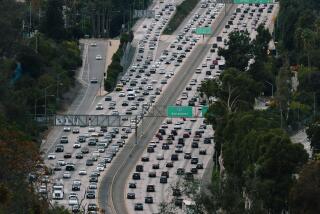On L.A. Freeways, the Ride Can Get Bumpy
- Share via
Mechanic Fernando Soto shakes his head when he talks about driving his tow truck on freeways in southeastern Los Angeles County.
“The suspension -- the roads destroy that,” said the 42-year-old Wilmington resident, who was visiting an auto parts store off the Del Amo exit of the Long Beach Freeway. “Right here on the freeways, you can see a lot of broken parts and blown-out tires.”
Soto said he fixed more than 10 cars a day, many damaged by gashes or holes in the pavement.
He wasn’t surprised to hear that the Road Information Program in Washington, D.C., reported recently that the Los Angeles metropolitan area had the bumpiest freeways and so-called arterial roads in the country.
The nonprofit research group, supported by insurance companies, auto equipment manufacturers and others, calculated that 66% of the Los Angeles area’s roadways were in poor condition and that jarring rides here added about $705 annually in repairs, depreciation and inefficient fuel use, in addition to the usual vehicle maintenance costs.
Five other California urban areas ranked among the nation’s 10 bumpiest: San Jose, San Francisco-Oakland, San Diego, Sacramento and Riverside-San Bernardino.
The group’s conclusions were based on information supplied by the states to the Federal Highway Administration.
Of the nation’s major cities, only Atlanta; Orlando, Fla.; and Jacksonville, Fla., maintained at least 75% of their roads in good condition.
“The high level of pavement deterioration on major metropolitan roads is a result of a significant increase in urban traffic, particularly from large trucks and other large vehicles,” the researchers wrote. “Further significant increases in travel in the years ahead will put further wear and tear on the roads and make it even more costly to improve and maintain them.”
The report pointed to a 2002 study by the U.S. Department of Transportation that found that urban road and highway pavement conditions would worsen at current funding levels.
“Keeping urban roadways in their current condition would require a 32% increase in annual funding, and improving the physical condition of urban roadways would require a 62% increase,” the department wrote.
Several transportation experts said they were not surprised that Los Angeles might have the roughest roads in the country.
Although the weather is kinder to pavement here than in snowy cities, the roads take a beating from the high volume of traffic, said Steve Finnegan, a transportation policy manager for the Automobile Club of Southern California.
“It’s a huge center of goods movement from the Pacific Rim,” he said. “A large number of trucks and cars are plying the roads every day.” About 25% of the products arriving in the U.S. come through the ports of Long Beach and Los Angeles, Auto Club officials said.
Finnegan said the state needed to stop borrowing from its transportation accounts to pay for other programs.
An Auto Club study last year found that about $400 million in annual maintenance had been deferred across the state, creating a burden for the future, Finnegan said.
“Clearly our road condition is deteriorating,” he said.
A spokesman for the California Department of Transportation said it was doing its best to maintain the freeways despite the impacts of California’s budget deficit.
“These are tough fiscal times the administration is going through, and it’s important to invest in transportation,” said spokesman David Anderson.
But he questioned the recent study’s methodology and conclusions. In Los Angeles, he said, 91% of the 869 miles of highway for which Caltrans is responsible “are either fair or good.”
The director of Los Angeles’ Bureau of Street Services also defended the condition of the city’s arterial roads.
A steady stream of state money designated for roads carrying bus traffic has enabled the city to improve the 2,000 miles of main streets, or “select system roads,” director Bill Robertson said.
“Basically, we’re up to C-plus on the select system roads,” he said. “Where we want to be is 85 to 86, a B to B-plus,” he said.
Over the next four years, Caltrans, which spends $700 million annually to maintain highways, has scheduled an additional $2.6 billion in preservation projects statewide, Anderson said.
The most expensive project is a $116-million rehabilitation of the Long Beach Freeway between Firestone Boulevard and the San Diego Freeway. Caltrans officials acknowledged that this nine-mile stretch, with blobs of asphalt filling in wok-sized holes, offered probably the most uncomfortable ride in Los Angeles County.
They said they hoped to rebuild it this fiscal year.
For Soto, the mechanic, that was good to hear.
“The 710 is the worst of any freeway,” he said. “I think twice before I get on it.” If he is traveling north or south, Soto said, he prefers Alameda Boulevard, which is more even.
Soto’s friend Carlos Garcia, who works at Amigo’s Auto Parts in Long Beach, said he also avoided the Long Beach Freeway when he could.
“I’ve got a suspension that’s half an inch off the ground,” said Garcia, 20, who drives a modified Honda Accord. “It used to hit everywhere.”
Several drivers said that other highways, including the Golden State Freeway and the San Bernardino Freeway, weren’t much smoother.
David Ma, 48, said harsh Los Angeles freeways had aged his car prematurely.
“Every two years, I have to change tires,” said Ma, who owns a video store just off the San Bernardino Freeway in Alhambra. “It says there is a four-year warranty, but I can never do four years.”
More to Read
Sign up for Essential California
The most important California stories and recommendations in your inbox every morning.
You may occasionally receive promotional content from the Los Angeles Times.










